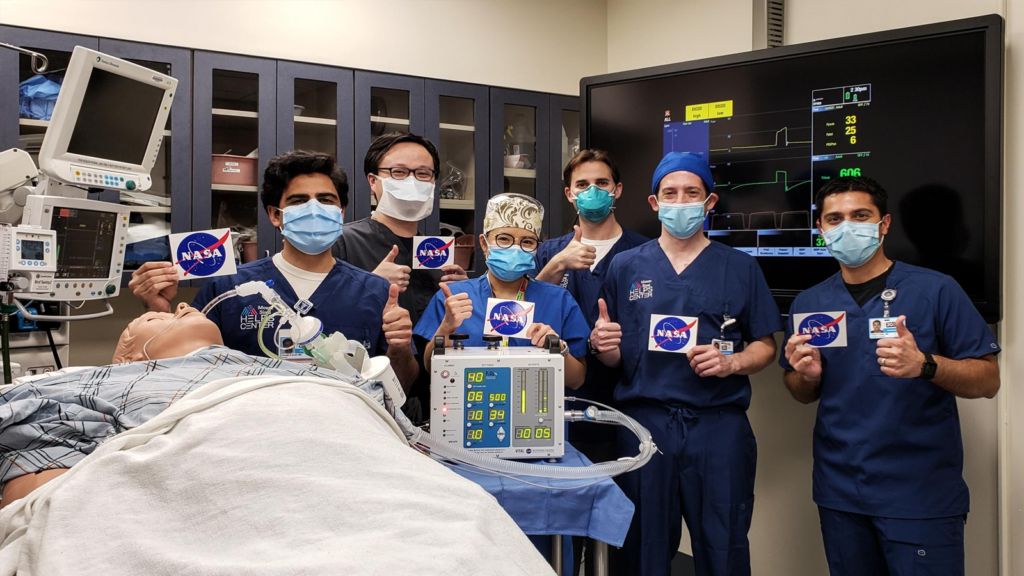Title example

Add Your Heading Text Here Lorem ipsum dolor sit amet, consectetur adipiscing elit. Ut elit tellus, luctus nec ullamcorper mattis, pulvinar dapibus leo. Lorem Ipsum is simply dummy text of the printing and typesetting industry. Lorem Ipsum has been the industry’s standard dummy text ever since the 1500s, when an unknown printer took a galley of type and scrambled it to make a type specimen book. It has survived not only five centuries, but also the leap into electronic typesetting, remaining essentially unchanged. It was popularised in the 1960s with the release of Letraset sheets containing Lorem Ipsum passages, and more recently with desktop publishing software like Aldus PageMaker including versions of Lorem Ipsum.
The Unexpected Link Between Nursing and Space Travel

Did you know that NASA has worked with nurses to improve healthcare technology? Some of the medical devices and techniques used in hospitals today were originally developed for astronauts! 1. Telemedicine: A NASA Innovation 2. IV Fluid Bags: Inspired by Space Missions 3. CPR Techniques Were Perfected for Zero Gravity 4. Infection Control Lessons from Space Stations Nurses and Space: A Perfect Match? With space tourism and missions to Mars on the horizon, future nurses may work in space stations or even on interplanetary missions. Nursing skills—like adaptability, crisis management, and innovation—are just as valuable in space as they are on Earth!Would you ever consider being a space nurse? 👩🚀👨⚕️
How to Improve Patient Communication as a Nurse

Effective communication is one of the most important skills a nurse can have. It not only improves patient trust but also helps prevent medical errors. Here are some practical tips to enhance communication with patients: 1. Practice Active Listening✔ Make eye contact and nod to show understanding.✔ Repeat key information back to confirm clarity.✔ Avoid interrupting when the patient speaks. 2. Use Simple Language✔ Avoid medical jargon—explain conditions in everyday terms.✔ Use metaphors or examples if needed (e.g., “Think of your heart like a pump”). 3. Show Empathy✔ A simple “I understand this must be difficult for you” can make a big difference.✔ Maintain a calm and reassuring tone. 4. Pay Attention to Body Language✔ Keep an open posture and avoid crossing arms.✔ Smile when appropriate to create a welcoming environment. 5. Confirm Understanding✔ Ask: “Can you repeat back what we discussed?”✔ Provide written instructions if needed. 6. Be Culturally Sensitive✔ Some cultures may have different ways of expressing pain or concern.✔ Always ask about preferences instead of assuming. Strong communication skills improve patient outcomes and make healthcare more compassionate. A few simple changes in how you speak and listen can make a world of difference!
The First Nurse Was a Warrior

When we think of the origins of nursing, Florence Nightingale usually comes to mind. However, the first recorded nurse in history was actually a warrior—Phoebe, mentioned in the Bible as a caregiver in ancient Rome. But even before Phoebe, nursing-like roles existed in early civilizations: 1. Ancient Egypt (3000 BCE) 2. Ancient Greece (5th Century BCE) 3. Medieval Europe (5th-15th Century) 4. The 19th Century Revolution Today, nursing continues to evolve, but its roots in courage, compassion, and dedication remain unchanged. From ancient healers to battlefield medics, nurses have always been heroes in healthcare.
The Origin of the Nursing Cap and Why It Disappeared

For decades, the nursing cap was an iconic symbol of the profession, representing cleanliness, discipline, and service. But did you know that its origins date back to the 19th century and were inspired by nuns’ habits? A Brief HistoryThe nursing cap was first introduced by Florence Nightingale, the founder of modern nursing, in the 1800s. At the time, nurses were expected to maintain a pristine and professional appearance. The cap served a dual purpose: keeping hair neatly tucked away and distinguishing trained nurses from untrained caregivers. By the early 20th century, nursing schools used different cap designs to signify rank and level of training. Some institutions even had a “capping ceremony” where student nurses received their first cap as a rite of passage into the profession. Why Did the Nursing Cap Disappear?In the 1970s and 1980s, the use of nursing caps declined significantly. Here’s why: Today, while the nursing cap has largely disappeared from hospitals, it remains a nostalgic symbol of the profession, often seen in historical photos, graduation ceremonies, and even Halloween costumes!
How to Stay Energized During Long Shifts

Nursing shifts can be exhausting, especially when working 12-hour rotations or night shifts. Staying energized and focused is essential not only for your well-being but also for providing the best possible patient care. Here are some practical tips to keep your energy levels up throughout the day (or night). 1. Stay HydratedDehydration can lead to fatigue, headaches, and dizziness. Carry a water bottle and sip throughout your shift. Adding electrolytes or herbal teas can also help maintain energy levels. 2. Eat SmartAvoid processed snacks and energy drinks that cause sugar crashes. Instead, opt for:✔ Protein-rich snacks (nuts, yogurt, hard-boiled eggs)✔ Complex carbohydrates (whole grains, fruits, vegetables)✔ Healthy fats (avocados, nuts, olive oil) 3. Take Short BreaksEven a 5-minute break can make a difference. Stretching, deep breathing, or a quick walk around the unit can boost circulation and refresh your mind. 4. Get Enough SleepSleep deprivation affects concentration and decision-making. If you work night shifts, establish a sleep routine, use blackout curtains, and minimize screen time before bed. 5. Wear Comfortable ShoesInvest in high-quality nursing shoes with proper arch support. Your feet, legs, and back will thank you! 6. Find Moments of JoyA quick laugh with coworkers, listening to a favorite song during a break, or practicing gratitude can help maintain a positive mindset, even during stressful shifts.
The First Nurse Was a Warrior

The global nursing workforce is facing one of its biggest challenges: a critical shortage of nurses. According to When we think of the origins of nursing, Florence Nightingale usually comes to mind. However, the first recorded nurse in history was actually a warrior—Phoebe, mentioned in the Bible as a caregiver in ancient Rome. But even before Phoebe, nursing-like roles existed in early civilizations: 1. Ancient Egypt (3000 BCE) 2. Ancient Greece (5th Century BCE) 3. Medieval Europe (5th-15th Century) 4. The 19th Century Revolution Today, nursing continues to evolve, but its roots in courage, compassion, and dedication remain unchanged. From ancient healers to battlefield medics, nurses have always been heroes in healthcare.


